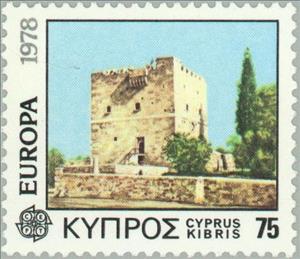Stamp: EUROPA/CEPT 1978 - Cyprus Architecture - Kolossi Castle (Cyprus 1978)
EUROPA/CEPT 1978 - Cyprus Architecture - Kolossi Castle (Cyprus 1978)
24 April (Cyprus ) within release C.E.P.T.- Monuments goes into circulation Stamp EUROPA/CEPT 1978 - Cyprus Architecture - Kolossi Castle face value 75 Cypriot mil
| Stamp EUROPA/CEPT 1978 - Cyprus Architecture - Kolossi Castle in catalogues | |
|---|---|
| Michel: | Mi:CY 485 |
Stamp is horizontal format.
Also in the issue C.E.P.T.- Monuments:
- Stamp - EUROPA/CEPT 1978 - Cyprus Architecture - Chrysoroyiatissa Mo face value 25;
- Stamp - EUROPA/CEPT 1978 - Cyprus Architecture - Kolossi Castle face value 75;
- Stamp - EUROPA/CEPT 1978 - Cyprus Architecture - Municipal Library o face value 125;
Stamp EUROPA/CEPT 1978 - Cyprus Architecture - Kolossi Castle it reflects the thematic directions:
The European Union (EU) is a supranational political and economic union of 27 member states that are located primarily in Europe.The Union has a total area of 4,233,255 km2 (1,634,469 sq mi) and an estimated total population of over 448 million. The EU has often been described as a sui generis political entity (without precedent or comparison) combining the characteristics of both a federation and a confederation
The European Conference of Postal and Telecommunications Administrations (CEPT) was established on June 26, 1959, as a coordinating body for European state telecommunications and postal organizations. The acronym comes from the French version of its name Conférence européenne des administrations des postes et des télécommunications.
The Europa postage stamp (also known as Europa - CEPT until 1992) is an annual joint issue of stamps with a common design or theme by postal administrations of member countries of the European Communities (1956-1959), the European Conference of Postal and Telecommunications Administrations (CEPT) from 1960 to 1992, and the PostEurop Association since 1993. Europe is the central theme. EUROPA stamps underlines cooperation in the posts domain, taking into account promotion of philately. They also build awareness of the common roots, culture and history of Europe and its common goals. As such, EUROPA stamp issues are among the most collected and most popular stamps in the world. Since the first issue in 1956, EUROPA stamps have been a tangible symbol of Europe’s desire for closer integration and cooperation.
A castle (from Latin: castellum) is a type of fortified structure built in Europe and the Middle East during the Middle Ages by European nobility. Scholars debate the scope of the word castle, but usually consider it to be the private fortified residence of a lord or noble. This is distinct from a palace, which is not fortified; from a fortress, which was not always a residence for nobility; and from a fortified settlement, which was a public defence – though there are many similarities among these types of construction. Usage of the term has varied over time and has been applied to structures as diverse as hill forts and country houses. Over the approximately 900 years that castles were built, they took on a great many forms with many different features, although some, such as curtain walls and arrowslits, were commonplace.





